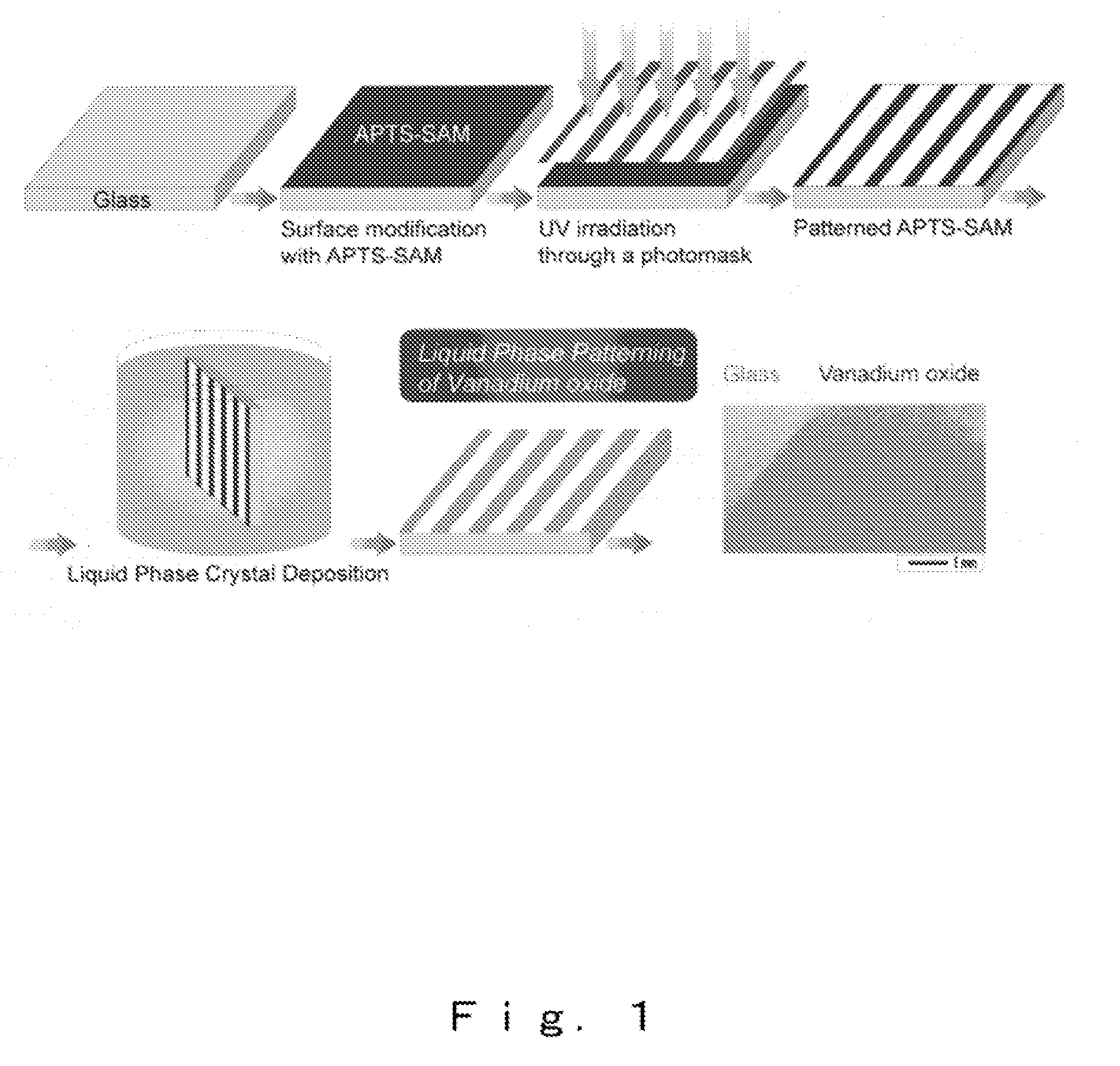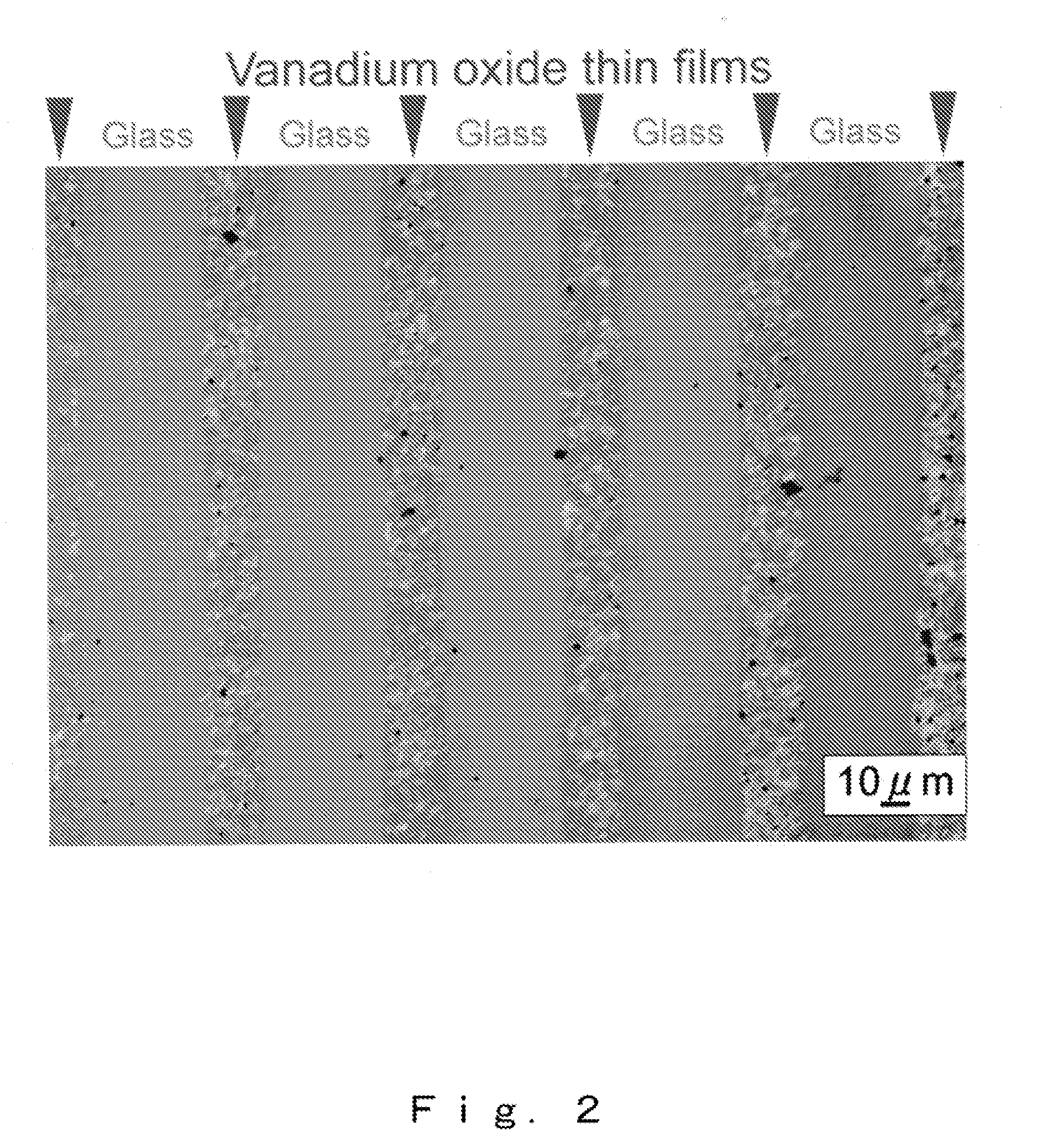Vanadium Oxide Thin Film Pattern and Method of Fabricating the Same
a technology of vanadium oxide and thin film pattern, which is applied in the direction of non-linear optics, instruments, transportation and packaging, etc., can solve the problems of difficult formation of large areas, serious impact on the desirable properties of vanadium oxide, and inability to coat on low-heat-resistance substrates, etc., to achieve the effect of easy coating
- Summary
- Abstract
- Description
- Claims
- Application Information
AI Technical Summary
Benefits of technology
Problems solved by technology
Method used
Image
Examples
example 1
[0081]In this example, a vanadium oxide thin film pattern was prepared on a glass substrate using a self-assembled monolayer.
[0082](1) Preparation of Self-Assembled Monolayer
[0083]In this example, preparation of a vanadium oxide thin film was attempted using a self-assembled monolayer. A glass substrate (Hioki #1737, Corning Co.) was washed by ultrasound washing for 5 minutes each with acetone, ethanol and ion-exchange water in that order.
[0084]This was then irradiated for 10 minutes with vacuum ultraviolet using a UV ozone cleaner (184.9 nm and 253.7 nm, low-pressure mercury lamp 200 W, PL21-200, SEN Lights Co.) to remove adsorbed organic matter from the surface of the glass substrate.
[0085]Next, the glass substrate surface was modified with an APTS-SAM (surface modification with APTS-SAM). The APTS (3-aminopropyltriethoxysilane, H2NC3H5Si(OCH3)3) was dissolved to 1 vol % in anhydrous toluene, and the glass substrate was dipped for 2 hours in a nitrogen atmosphere in a glove box (V...
example 2
[0092](1) (Evaluation Methods)
[0093]In this example, the method in Example 1 described above is applied, and the zeta potentials of the particles produced in aqueous solution, the APTS self-assembled monolayer and the ATPS self-assembled monolayer after exposure to vacuum ultraviolet were measured with a laser zeta potentiometer (ELS-7300K, Otsuka Electronics Co., Ltd.).
[0094]The thin-film micropattern was observed with an optical microscope (BX51W1 Microscope, Olympus Optical Co., Ltd.) and an electron microscope (FE-SEM; JSM-6335F, JEOL Ltd.).
[0095]The crystal structure was evaluated with an X-ray diffraction meter (CuKα radiation XRD; RAD-1C, Rigaku). The transmissibility of the thin film at 25° C. and 70° C. was measured using a UV / VIS / NIR spectrophotometer (V-570, Jasco).
[0096]The samples in this case were fixed in an aluminum sample holder, and heated to 70° C. with an electrical heater fixed to the sample holder. The temperature of the thin film was measured with a thermocoup...
example 3
[0101](1) Morphology of Thin Film Surface
[0102]In this example, the detailed morphology of the surface of the thin film prepared in Example 1 above was observed by scanning electron microscopy. Before platinum coating, the sample exhibited a strong white color in the silanol group region in contrast with the amino group region, and this is attributed to strong electrical charging of the glass surface of the silanol region from electron beam irradiation. This indicates the difference in surface state between the glass and the vanadium oxide.
[0103]The patterned thin film was coated with 3 nm of platinum for an antistatic, and observed again. FIG. 3 shows an electron microscope image (3a) of the vanadium oxide images film pattern. (3b to 3d) of FIG. 3 show enlarged photographs of the vanadium oxide thin film surface. The amino group region appears somewhat whiter than the silanol group region, and this is attributed to thin film formation on the amino group region (FIG. 3a).
[0104]At hi...
PUM
| Property | Measurement | Unit |
|---|---|---|
| temperature | aaaaa | aaaaa |
| boiling point | aaaaa | aaaaa |
| pH | aaaaa | aaaaa |
Abstract
Description
Claims
Application Information
 Login to View More
Login to View More - R&D
- Intellectual Property
- Life Sciences
- Materials
- Tech Scout
- Unparalleled Data Quality
- Higher Quality Content
- 60% Fewer Hallucinations
Browse by: Latest US Patents, China's latest patents, Technical Efficacy Thesaurus, Application Domain, Technology Topic, Popular Technical Reports.
© 2025 PatSnap. All rights reserved.Legal|Privacy policy|Modern Slavery Act Transparency Statement|Sitemap|About US| Contact US: help@patsnap.com



